Arne Jacobsen: The History of Danish Design
In the hushed lobby of Copenhagen’s SAS Royal Hotel in 1960, a silent revolution takes place. Travelers discover for the first time furniture with unprecedented organic forms, sculpted like protective cocoons in the bustle of the modern world. These revolutionary creations bear the signature of Arne Jacobsen (1902-1971), the man who transformed Danish architecture into a universal language of design.
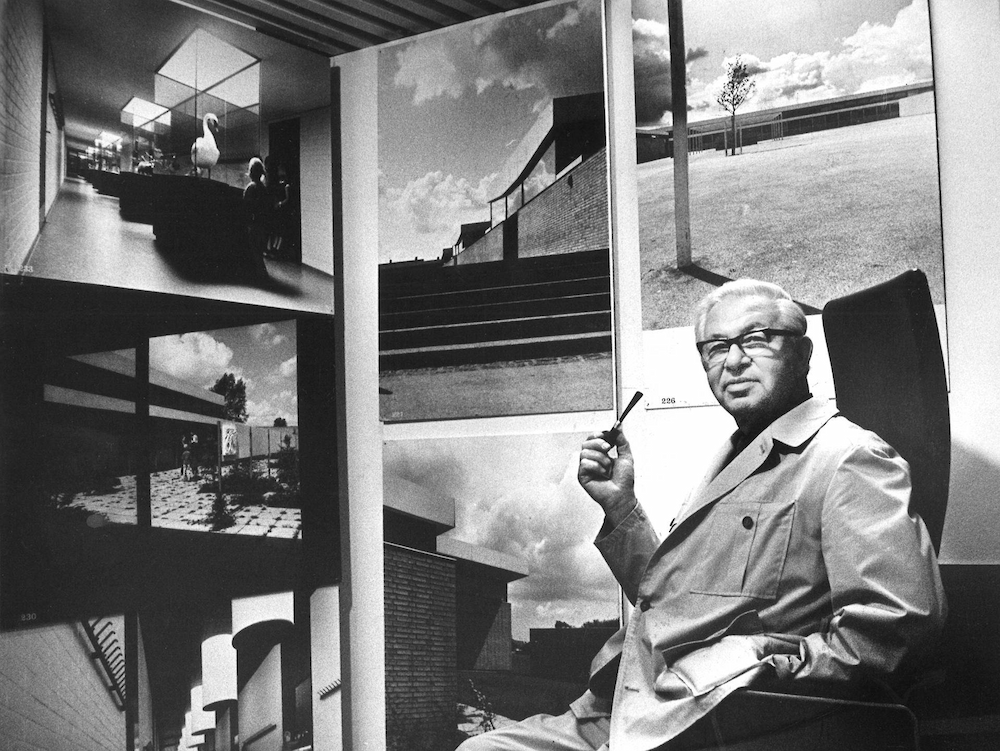
Jacobsen embodies more than a creator: he is the visionary of “total design“, this holistic approach where every element, from building to ashtray, participates in a global harmony. His legacy continues to shape our relationship with space and contemporary furniture.
Biography & Career
Birth and revelatory training Born in Copenhagen on February 11, 1902, Arne Emil Jacobsen grew up in a bourgeois family that cultivated a taste for decorative arts. From childhood, he showed particular sensitivity to forms and materials, spending hours observing the floral patterns of the family garden – a fascination that would later appear in his textile creations.
Graduated in 1927 from the Royal Danish Academy of Fine Arts, Jacobsen quickly established himself as one of the spearheads of the Scandinavian modernist movement. Unlike his contemporaries who compartmentalized their disciplines, he developed a global architectural vision where furniture becomes the natural extension of built space.
Career Key Moments
- 1929: First international recognition with the “House of the Future” built for an exhibition in Copenhagen
- 1937-1943: Exile in Sweden during Nazi occupation, fruitful period of textile experimentation
- 1952: Commission for Munkegård School which established his reputation as architect-designer
- 1958-1960: Creative apotheosis with the SAS Royal Hotel, laboratory of his most famous furniture innovations
Cultural and historical context: Arne Jacobsen evolved in post-war Denmark, a prosperous nation that reinvented its identity through design. The “Danish miracle” of the 1950s transformed this small Nordic country into a global reference for modern furniture, thanks to creators like Jacobsen who knew how to combine Scandinavian rigor with formal sensuality.
Arne Jacobsen’s Emblematic Works
Egg Chair (1958)
Description Commissioned specifically for the SAS Royal Hotel lobby, the Egg Chair revolutionizes the art of seating through its unprecedented sculptural approach. Carved from polyurethane foam using a technique borrowed from the automotive industry, this 107 cm high creation perfectly follows the contours of the human body. Its enveloping shell, covered in Fritz Hansen leather or fabric, rests on a polished aluminum swivel base that allows complete 360° rotation.
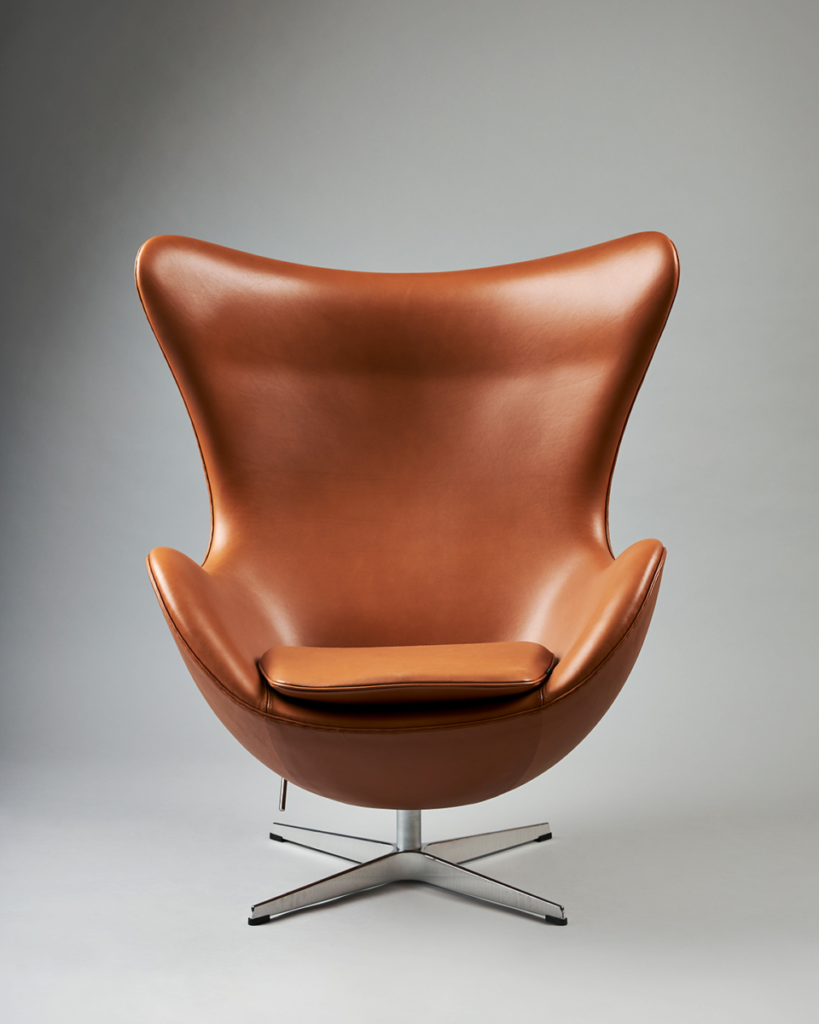
The technical innovation lay in the manufacturing process: Jacobsen personally sculpted the prototype in clay in his garage, creating a perfectly ergonomic form without any straight lines.
Critical reception Initially controversial due to its formal audacity, the Egg Chair quickly established itself as the embodiment of modern Danish design. It revolutionized the approach to lounge seating, creating a new standard of intimacy in public space.
Market (New & Used)
- New (Fritz Hansen): €7,200 to €10,400 depending on finishes (Classic leather, Semi-Aniline or Hallingdal fabric)
- US Edition (Design Within Reach): $8,660 (~€8,000) with personalized options
- Used/Vintage: €8,800 to €16,500 depending on condition and provenance
- Rarity: First editions 1958-1965 reach record prices, particularly in original cognac leather
Swan Chair (1958)
Description Designed simultaneously with the Egg Chair for the same hotel project, the Swan Chair explores a more accessible approach to organic design. Its silhouette effectively evokes a swan with outstretched wings, with a molded fiberglass shell covered with foam and upholstered in leather or fabric. The cruciform aluminum base, identical to that of the Egg, ensures stability and elegance.
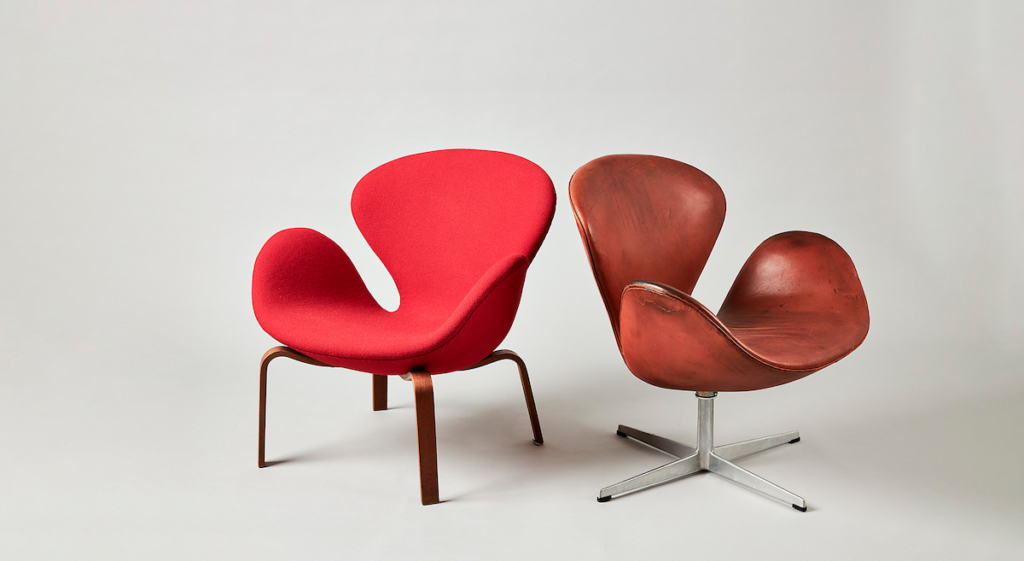
More compact than its sister (76 cm high), it adapts perfectly to domestic spaces while preserving Jacobsen’s revolutionary formal vocabulary.
Critical reception Praised as a perfect synthesis between comfort and aesthetics, the Swan Chair democratizes the sculptural approach to Danish furniture. It quickly becomes the icon of accessible Scandinavian design.
Market (New & Used)
- New (Fritz Hansen): €4,500 to €6,200 depending on finishes
- USA (current): $5,500 (~€5,100)
- Used/Vintage: €4,800 to €8,500 for period editions
- Trend: Versions in camel or black leather from the 1960s are particularly sought after
Grand Prix Chair (1957)
Description Created for Novo restaurants, this chair reveals Jacobsen’s genius in the art of molded plywood. Its slender silhouette, cut from a single sheet of veneer, is inspired by the medal it won at the 1957 international furniture competition. Initial versions offer finishes in teak, rosewood or ash, mounted on an extremely fine chrome tubular base.
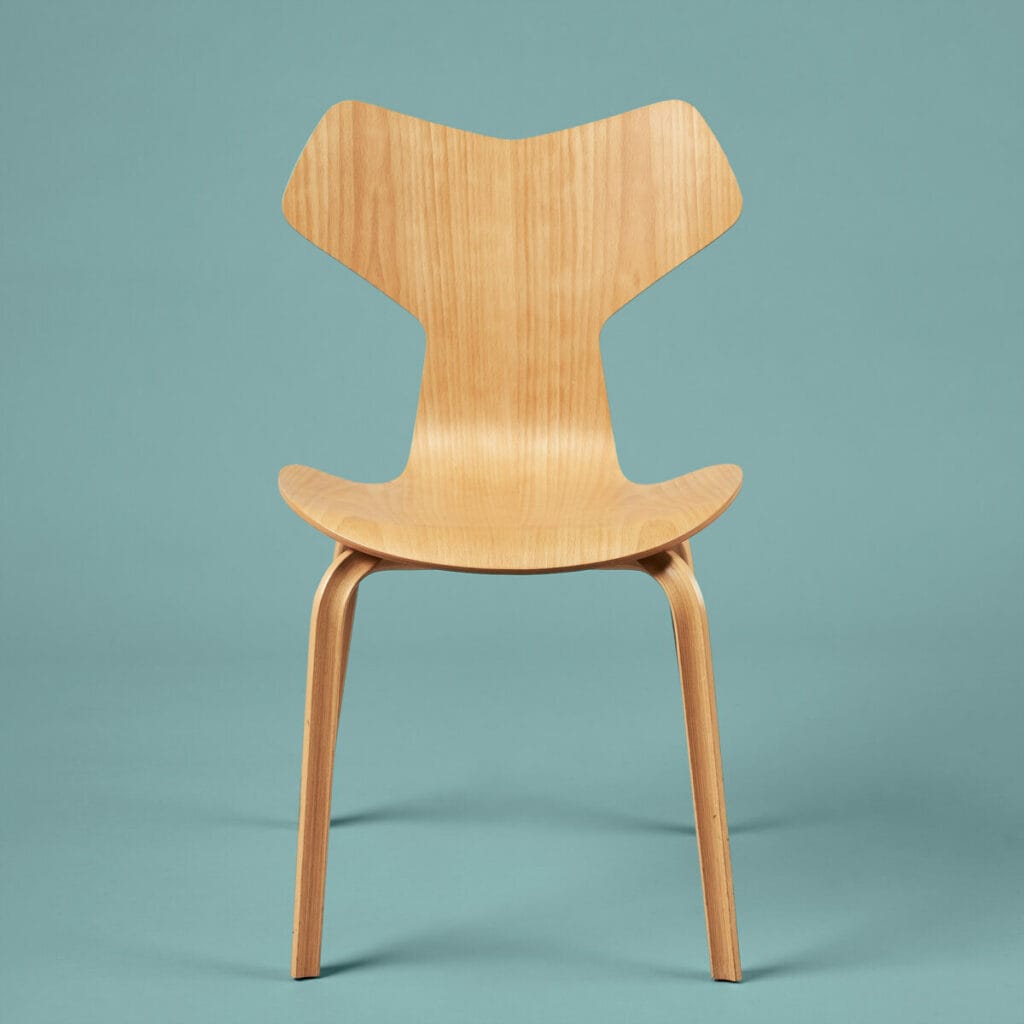
The technical prowess lay in the bending of plywood, allowing natural flexibility that ensures comfort without padding.
Critical reception Immediately adopted by the international architectural avant-garde, it embodies Nordic elegance at its peak. Its apparent simplicity hides remarkable technical sophistication.
Market (New & Used)
- New (Fritz Hansen): €640 to €2,200 depending on finish (standard veneer to full leather)
- Vintage 1960s: €4,300 for a rare rosewood pair
- Limited editions: Precious wood versions reach €6,000 per pair
- Note: Contemporary ash re-editions represent excellent value for money
Drop Chair (1958)
Description Little known but fascinating, the Drop Chair illustrates Jacobsen’s continued exploration of organic forms. Designed parallel to the famous Egg and Swan, this chair takes its name from its silhouette evoking a suspended water drop. Its asymmetrical molded fiberglass shell, more radical than its sisters, offers unexpected comfort thanks to its curves perfectly following human anatomy.

The polished aluminum cruciform base, identical to that of other SAS Royal Hotel creations, ensures remarkable stability despite the formal audacity. Available in leather or fabric upholstery, it measures 85 cm in height and 78 cm in width.
Critical reception Initially overshadowed by the immediate success of the Egg Chair, the Drop Chair now enjoys late recognition among collectors and connoisseurs. Its relative rarity makes it a particularly sought-after piece.
Market (New & Used)
- New (Fritz Hansen): €6,800 to €9,200 depending on finishes (limited production)
- Used/Vintage: €12,000 to €18,000 for period editions (1958-1965)
- Exceptional rarity: Less than 500 vintage examples catalogued worldwide
- Trend: Strong valorization (+25% per year) due to its recent rediscovery
Ant Chair (1952)
Description Jacobsen’s first successful foray into molded plywood, the Ant Chair takes its name from its silhouette evoking an ant seen in profile. Initially designed for the Novo pharmaceutical company cafeteria, this stackable chair revolutionizes collective furniture through its lightness (2.5 kg) and resistance.
Its monoblock shell, cut and molded from beech plywood, rests on three chrome tubular legs – an ergonomic innovation that ensures perfect stability.
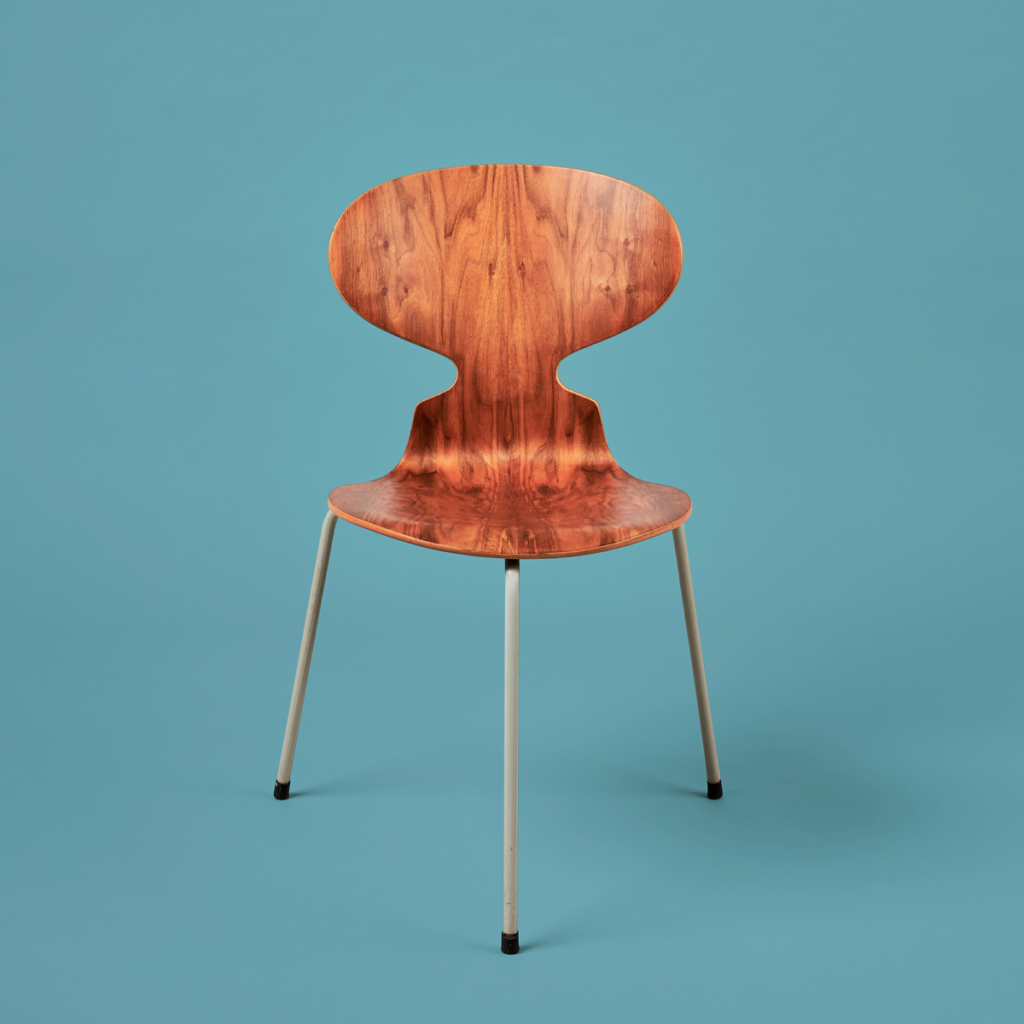
Critical reception Praised for its exemplary functionalist approach, the Ant Chair democratizes modern design in collective spaces. It quickly becomes an international standard.
Market (New & Used)
- New (Fritz Hansen): €280 to €450 depending on finish
- Original vintage 1952-1960: €800 to €1,500 depending on condition
- Limited series: Colored editions from the 1960s up to €2,000
Series 7 Chair (1955)
Description Perfected evolution of the Ant Chair, the Series 7 adds a fourth leg for increased comfort. Its redesigned backrest offers better lumbar support, while its refined shell preserves Jacobsen’s aesthetic signature. Available as chair, stool or high chair, it declines the Jacobsenian formal vocabulary in all situations.
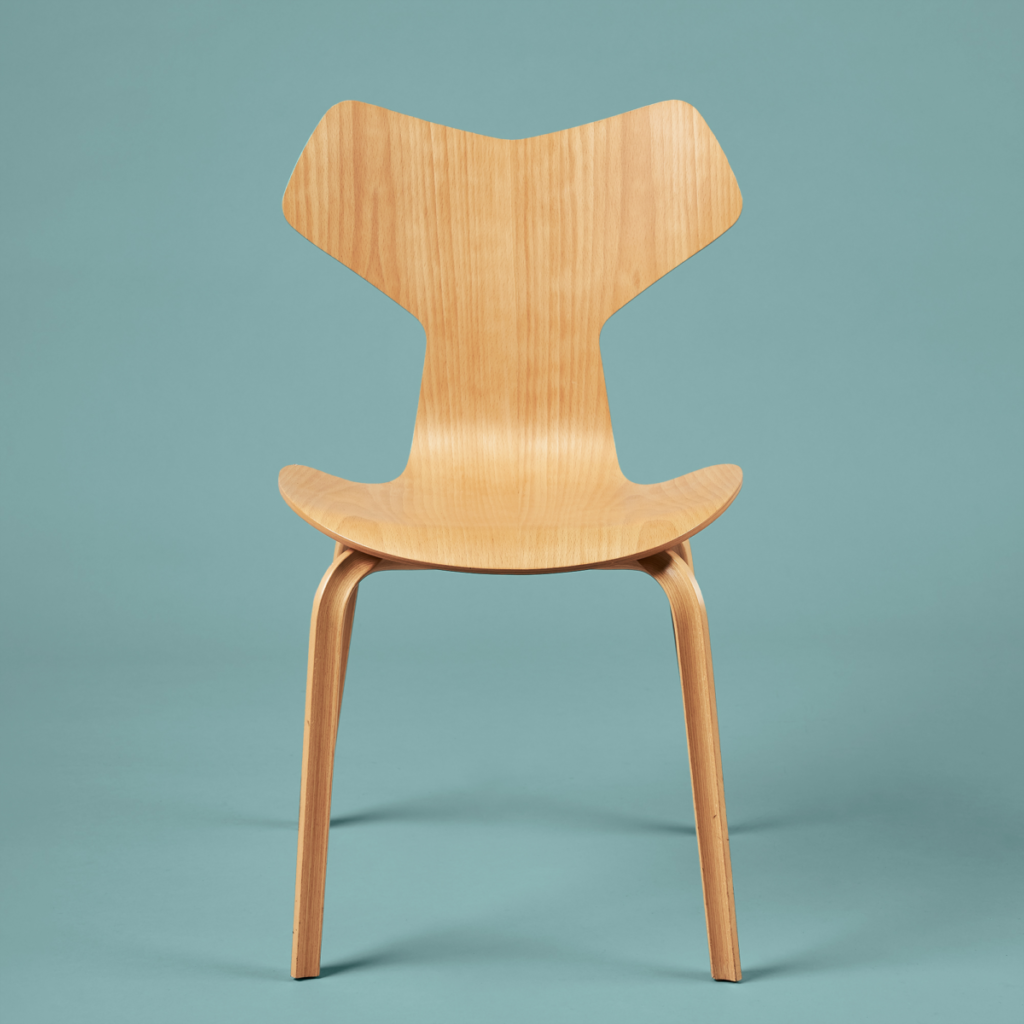
Critical reception Acclaimed as the best-selling seat in design history (over 5 million copies), it definitively validates the industrial approach to Danish design.
Market (New & Used)
- New (Fritz Hansen): €320 to €650 depending on finish and height
- Vintage first series: €600 to €1,200 depending on rarity
- Special editions: Lacquered versions from the 1960s up to €1,800
4. Philosophy & Style
Fundamental aesthetic principles Jacobsen develops a philosophy of “functional organic design” that revolutionizes the approach to modern furniture. His creations arise from meticulous observation of nature – curves of an egg, profile of a swan, leaf veins – which he transposes into a contemporary industrial language.
“I never draw an armchair as an armchair, I first draw a form, then I discover how to inhabit it“, he confided in 1965. This sculptural approach radically distinguishes his work from the geometric rationality of the Bauhaus.
Technical approach and materials Pioneer in the use of new materials (fiberglass, polyurethane foam, molded plywood), Jacobsen masters the art of industrial production without sacrificing artisanal sensitivity. Each prototype is born from manual experimentation – clay sculpture, cardboard models – before being industrialized.
His genius lies in this synthesis between technical innovation and formal sensuality, creating objects that are both revolutionary and timeless.
Total design conception Jacobsen revolutionizes architectural practice by simultaneously designing the built envelope and its furniture. This holistic approach, inherited from British Arts & Crafts, finds its apotheosis in the SAS Royal Hotel where he designs everything, from structure to cutlery, including fabrics and lighting.
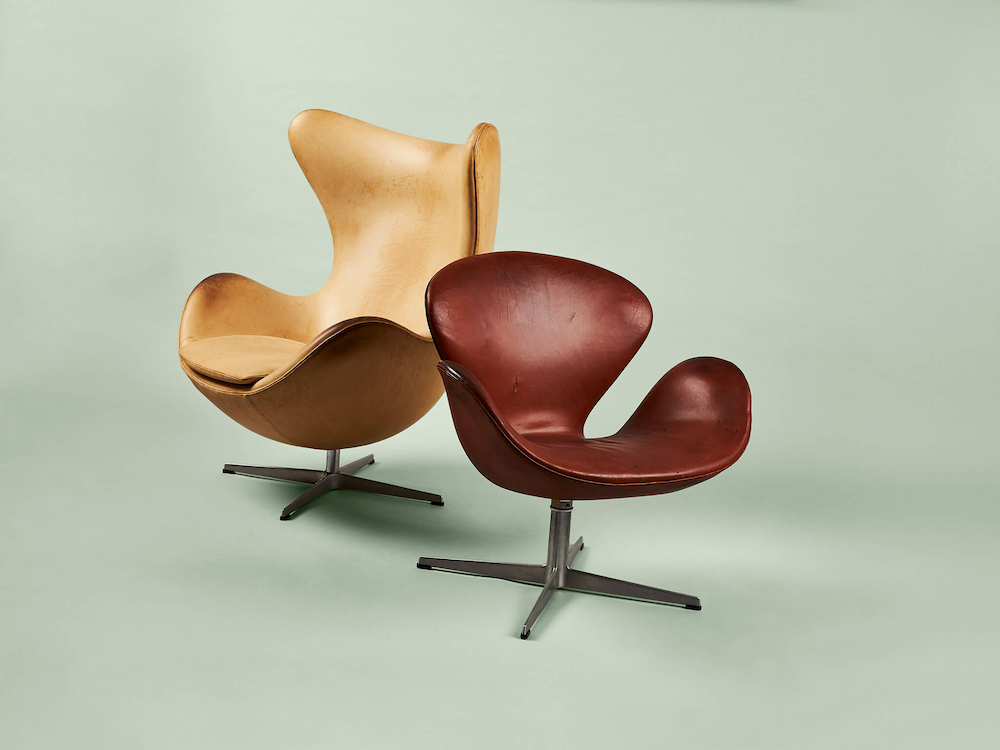
5. Influences & Heritage
Formative inspirations Jacobsen draws his inspiration from three main sources: Gunnar Asplund’s Scandinavian functionalism, Alvar Aalto’s organicism and direct observation of Danish nature. His study trips to Germany (1927) and his discovery of & nourish his reflection on design industrialization.
The determining influence of Charles and Ray Eames, met during a trip to the United States in 1951, encourages him to explore the possibilities of molded plywood and new synthetic materials.
Transmission and posterity Jacobsen’s influence irrigates all contemporary Scandinavian design production. His former collaborators – Jørn Utzon, Verner Panton – perpetuate his organic approach, while contemporary creators like Ronan & Erwan Bouroullec or Jaime Hayon explicitly claim his heritage.
Impact on contemporary design The Jacobsenian formal vocabulary continues to inspire the contemporary furniture industry. Brands like &tradition, Muuto or HAY develop collections directly inspired by his organic aesthetic, proving the persistent modernity of his approach.
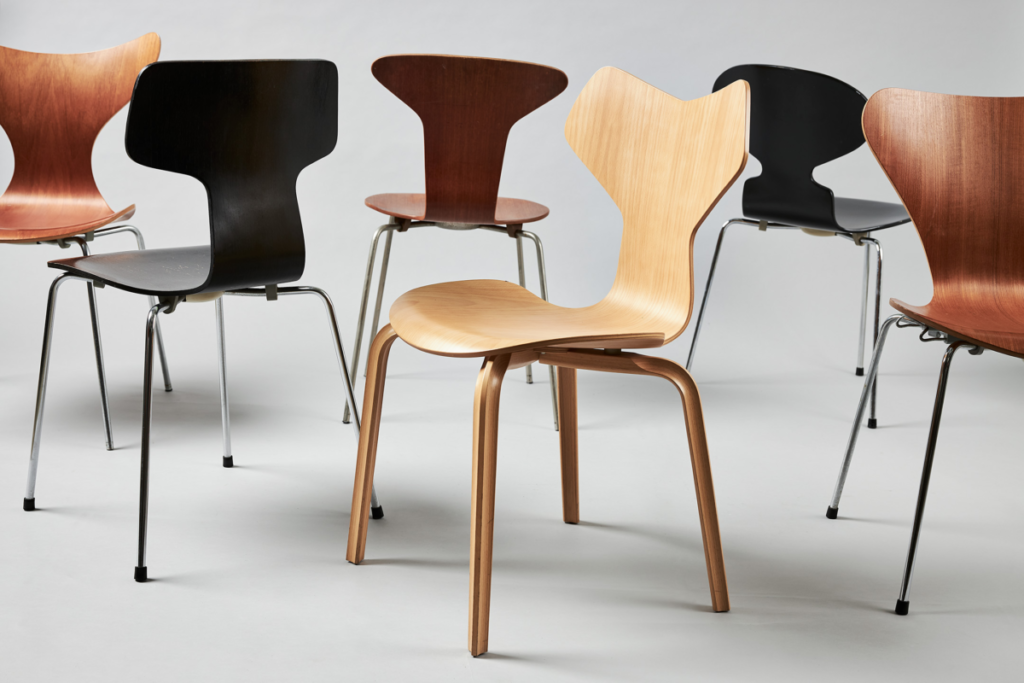
6. Recognition
International distinctions
- 1957: International furniture Grand Prix for the Grand Prix Chair
- 1963: C.F. Hansen Medal from the Royal Danish Academy
- 1971: Honorary member of the Royal Institute of British Architects
Museum presence Jacobsen’s creations enrich the permanent collections of the most prestigious institutions: MoMA New York, Victoria & Albert Museum London, Vitra Design Museum, Musée des Arts Décoratifs Paris. The French Mobilier National regularly acquires his pieces for official residences.
Edition and distribution Fritz Hansen, exclusive partner since 1958, continues to produce the entire Jacobsen catalog according to original quality standards. This editorial fidelity guarantees the work’s permanence and international distribution.
7. New and Used Buying Guide
Recognizing original Fritz Hansen editions
Egg Chair, Swan Chair & Drop Chair:
- Authentication: Fritz Hansen metal label under the seat, security hologram since 2006
- Base: Original polished aluminum (not chromed), smooth rotation on precision bearings
- Stitching: Perfect regularity, invisible stitches on premium leather versions
- Foam: Progressive density (firm in center, softer at extremities)
Grand Prix & Series 7:
- Plywood: Regular grain, characteristic satin finish
- Stamping: Fritz Hansen logo engraved under the seat
- Legs: Chrome or lacquered tubes of uniform thickness, invisible fixings
Avoiding counterfeits
- Suspicious prices: Be wary if 50% cheaper than Fritz Hansen rate
- Materials: ABS plastic instead of fiberglass, overly bright chrome
- Finishes: Irregular stitching, overly soft foams, fanciful labels
- Provenance: Favor authorized Fritz Hansen dealers
Investment advice Vintage Jacobsen pieces (1958-1970) constitute excellent investments, particularly:
- Egg Chair first series in cognac leather: +15% per year
- Swan Chair limited editions 1960s: +12% per year
- Drop Chair period editions: +25% per year (exceptional rarity)
- Grand Prix Chair in rosewood: +20% per year
Verification resources
- Fritz Hansen Archives: paid authentication (€150)
- Design Within Reach expertise for the American market
- Vitra Design Museum database for museum pieces
The Jacobsen Revolution
Arne Jacobsen revolutionized the art of furniture by reconciling modern industrial requirements with the organic sensuality of Scandinavian nature. His “total design” approach continues to inspire contemporary creators who draw from it both a method and an aesthetic.
His iconic creations – Egg, Swan, Drop Chair, Series 7 – transcend their primary function to become timeless symbols of a Danish way of life now universal. In a world seeking authenticity and sustainability, the Jacobsenian heritage reminds us that technical excellence and formal poetry never oppose each other.
To deepen your discovery:
- Visit the Fritz Hansen Universe to explore the complete collection
- Discover the permanent exhibition at the Design Museum Denmark in Copenhagen
- Consult the reference monograph “Arne Jacobsen: Objects & Furniture” (Hatje Cantz, 2022)
Resources
Design Fundamentals
Hart Design Glossary from A to Z
Sabre legs, patina, passementerie, caning… This lexicon gives meaning to the technical and stylistic terms often used in the design world.
Access the Hart Design GlossaryHart Glossary of Design Icons
This glossary lists all the great names in design and decoration in alphabetical order. Discover the creators who have shaped contemporary living art.
Access the Hart Glossary of Design Icons
Digital entrepreneur and craft artisan, I use my unconventional background to share my vision of luxury design and interior decoration — one enriched by craftsmanship, history, and contemporary creation. Since 2012, I have been working daily in my workshop on the shores of Lake Annecy, creating bespoke interiors for discerning decorators and private clients.
